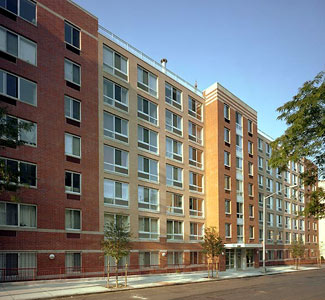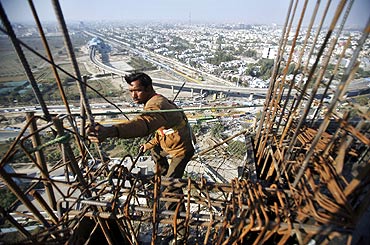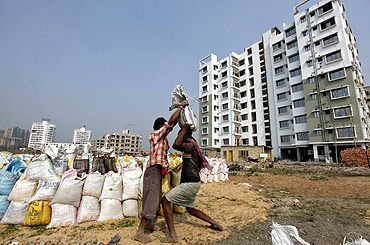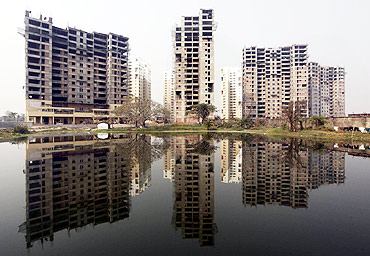
Ansal Properties and Infrastructure, Omaxe and Parsvnath, which get majority of their sales from smaller towns, beat the poor sentiments in the metros by selling stocks in smaller towns that were more stable and immune to interest rate rise.
While Ansal Properties and Infrastructure sold 22.43 million sq ft in 2010-11, 64.6 per cent more than what it sold last year, Puravankara Projects, along with its subsidiary, sold 3.10 million sq ft in the financial year 2010-11 - up 25 per cent of 2009-10 figures.
...

Omaxe, however, sold 9.76 million sq ft in 2011, marginally lower than the 10.7 million sq ft it sold in 2010.
On the other hand, bigger developers like Unitech, DLF and HDIL that focused on metro markets, sold lesser stocks than last year.
Unitech sold 9.16 million sq ft, a decline of 45 per cent from the 16.6 million sq ft recorded 2009-10.
For Unitech, this translates into sales of Rs 4,323 crore (Rs. 43.23 billion) - down 38.5 per cent from the Rs. 7,033 crore (Rs. 70.33 billion) it clocked in the previous financial year.
...

DLF sales dropped to Rs. 6,658 crore (Rs. 66.58 billion) in 2010-11, seven per cent lower than the Rs. 7,150 crore (Rs. 71.5 billion) during the previous financial year.
Realtors who focused on smaller towns did well because the small town consumer depends less on loans and rely on self-financing to fund half the cost of a property.
"Smaller towns don't exhibit volatile cycles that tier-I markets do. In 2008, when prices in NCR crashed 30 per cent, Lucknow was stable. tier-2 markets are not dependent on interest rates or how exports are doing," says Pankaj Bajaj, CEO, Eldeco Properties.
...

"Land costs in tier-II or tier-III towns are 50 per cent lower than tier one towns. Besides, competition is lower as there are very few large developers in smaller towns. So, you have a better branding effect," said a senior executive with Ansal Properties.
Smaller towns also allow developers faster cash flows. In Tier-one cities, higher land cost force developers to take higher debts.
In smaller towns, aggregation is easier, and so is the process of converting agricultural land into non-agricultural land as laid out by the city development authorities who are keen to promote development.
...

"Cash flows are better in smaller towns as you can quickly develop and monetise the land," said another developer.
Yet, Tier-II towns have their limitations (like lower realisations per sq ft), while tier-I cities have their own charm.
"Diversifying your risks always helps than putting your eggs in one basket.
In Mumbai, the realisations can be as high as Rs. 30,000-35,000 a sq ft or Rs. 10,000-12,000 per sq ft. It is a different ball game," said an Ansal executive.
The last few years also saw bigger developers making a beeline for smaller towns with DLF, Unitech and Emaar MGF launching townships in Mohali, Indore, Ambala and Jaipur.
In the first phase, they have sold plots, which have been received well. Prices have already gone up in these projects, which has brought more investors.